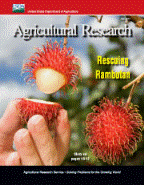United States Department of Agriculture: Agricultural Research Service, Lincoln, Nebraska

Agricultural Research Magazine
Date of this Version
8-2013
Document Type
Article
Citation
Agricultural Research 61(7): August 2013; ISSN 0002-161X
Abstract
The European Space Agency’s Soil Moisture and Ocean Salinity (SMOS) mission includes the latest advance in using Earth-orbiting satellites for estimating soil moisture across the globe. The SMOS satellite was launched in 2009 and was designed to estimate soil moisture levels to within 4 percent, which is like measuring a teaspoon of water in a handful of dry soil.
To capture this data, SMOS uses a new sensor technology that is the first passive L-band system—measuring microwave radiation emitted around the frequency of 1.4 gigahertz—in routine operation. But the accuracy of the information collected by this new technology still needs to be verified with actual soil moisture measurements, a task perfectly suited for a team of Agricultural Research Service scientists.
In 2002, ARS scientists established soil moisture monitoring networks in four of the agency’s long-term experimental watersheds to verify the accuracy of soil moisture data collected by other Earth-orbiting satellites. The researchers have been monitoring soil moisture levels in these networks—located in ARS watersheds at Walnut Gulch, Arizona; Little Washita, Oklahoma; Little River, Georgia; and Reynolds Creek, Idaho—hourly since 2002. So they had a vast amount of data from a range of environments they could use to validate SMOS soil moisture measurements.
Included in
Agriculture Commons, Animal Sciences Commons, Food Science Commons, Plant Sciences Commons

